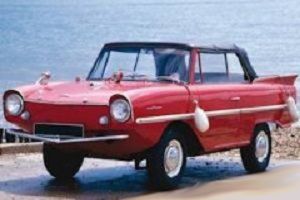The Amphicar is the only amphibious car to reach proper mass-production. As a plaything for rivers and calm lakes it was enormous fun. But for anything more seagoing it was a precarious hazard, as shown in 1965 by a revealing report in Autocar magazine. Two Amphicars attempted to cross the English Channel. One broke down after letting in too much water and the second had to tow it, after disentangling the towrope from its propellers.

Amphicar 770 1961
- YEAR REVEALED 1961
- PLACE OF ORIGIN Berlin, West Germany
- HISTORICAL STATUS production car
- ENGINE four-cylinder, 70ci (1,147 cc)
- MAXIMUM POWER 43bhp
- LAYOUT rear-mounted engine driving the rear wheels
- BODYWORK four-seater convertible
- TOP SPEED 70mph (112kph) on land; 7mph (12kph) in water
- NUMBER BUILT 3,878
When the overworked car’s puny 12-gallon (45-liter) fuel tank was empty, it had to be refilled. “A rather precarious operation,” the report noted, “which involved opening the roof and pouring the fuel into the tank from over the windscreen”. No doubt the German manufacturer didn’t advocate this type of journey, but the cars did finally reach land. They were aimed primarily at rich outdoorsmen in the US, where 80 percent of Amphicars were sold. The car was designed by German engineer Hans Trippel.
It had a 70ci (1,147cc) Triumph Herald engine, a two-part transmission with an adapted VW Beetle gearbox for the road, and a two-speed (forward-and-back) in-water unit. The wheels and the twin propellers could operate independently and the steering wheel controlled the rudders – the front wheels. Manufacture stopped in 1963 after over-ambitious forecasts produced a huge inventory of parts. Amphicars were then built from the remaining stock until 1968.